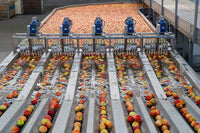Bleach has been the go-to disinfectant for decades. But times are changing.
Today’s consumers and industries want safer, faster, and more sustainable solutions—and hypochlorous acid (HOCl) is leading the charge.
If you're still using bleach, this blog will change the way you see sanitation.
The Problem With Bleach
Bleach (sodium hypochlorite) is a strong disinfectant, but it comes with serious downsides:
-
Requires PPE to handle
-
Not safe for skin or food contact
-
Leaves harmful residues
-
Causes corrosion and damage to surfaces
-
Produces toxic fumes and byproducts
-
Must be rinsed off after use
-
Degrades and loses potency over time
HOCl vs Bleach: Feature Showdown
| Feature | Bleach | HOCl |
|---|---|---|
| Kills bacteria and viruses | ✅ | ✅ |
| Safe for food contact | ❌ | ✅ |
| No rinse required | ❌ | ✅ |
| Safe on skin | ❌ | ✅ |
| Odorless and fume-free | ❌ | ✅ |
| Non-corrosive | ❌ | ✅ |
| Safe for kids and pets | ❌ | ✅ |
| Can be produced on-site | ❌ | ✅ |
| pH balanced | ❌ | ✅ |
| Environmentally friendly | ❌ | ✅ |
Why HOCl Works Better
HOCl is the same molecule your white blood cells produce to fight infection.
It’s highly effective at penetrating pathogen cell walls—yet remains non-toxic to humans.
HOCl is also up to 100 times more effective than bleach at killing certain pathogens at equal concentrations.
The Hidden Costs of Bleach
When you use bleach, you're paying for more than just the bottle:
-
PPE and employee training
-
Post-use rinsing and water waste
-
Extra labor time
-
Chemical storage and inventory
-
Damage to surfaces and equipment
-
Environmental compliance fees
In high-stakes settings like healthcare and food production, even small bleach-related mistakes can carry major risk.
Why Leading Brands Are Switching to HOCl
Companies like Norwegian Cruise Line switched after dealing with costly damage and sanitation challenges caused by bleach.
Now, they generate HOCl on-site with EcoloxTech systems, reducing outbreaks and chemical waste.
Other adopters include restaurants, dental offices, seafood processors, and cannabis labs—choosing HOCl to:
-
Protect staff and customers
-
Lower operational costs
-
Increase safety and compliance
How to Switch from Bleach to HOCl
With EcoloxTech’s on-site generators, you can make fresh, effective HOCl in-house—for just pennies per gallon:
-
No hazardous shipping
-
No corrosive storage
-
No supply delays
Choose from:
-
Eco One – for homes and small clinics
-
E-300 – ideal for schools, restaurants, labs
-
E-1200 – for factories, processing plants, large facilities
Make the Clean Switch Today
Want to ditch bleach but keep the kill power?
✅ Get a custom quote
✅ Use our bleach replacement calculator
✅ Try a demo unit





